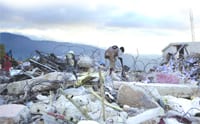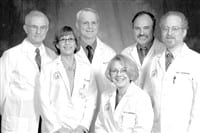Picking Up the Pieces Long After the Quake, Haiti Is Still a Shaken Land
For Dr. John Santoro, volunteering in Haiti after January’s devastating earthquake was what he called “a time of contrast.” Actually, it was like stepping into a different world.
“We flew down from Springfield to pick up eight children who were badly injured and needed care,” said Santoro, vice chairman of Emergency Medicine at Baystate Medical Center. “We were sent on a private jet to pick them up; it was really luxurious.
“But when we got there, the contrast with the poverty and the living conditions — even under normal circumstances — was dramatic. After the quake, well, you can just imagine.”
David Powers was also on that jet. An emergency department nurse at Mercy Medical Center, he too wanted to lend his skills to the quake-stricken island.
“It’s such a poor country — unbelievable poverty,” he said. “Coming in, we saw a tin shack that looked like it would fall over; that was the control tower. We were like, ‘oh my God, this is in rough shape.’ But when we got back to the airport, it looked pretty nice; everything else is worse.
“It’s eye-opening,” he said of driving to the hospital in the town of Minot, where the nine-person medical team from Baystate and Mercy would spend a week, and passing by the tin shacks where people lived — if they had that much over their heads. “I’ve been around the country and in different third-world nations, and this was by far the worst I’ve ever seen.”
The group of Springfield doctors, nurses, and physician assistants arrived in an area relatively spared by the earthquake — at least compared to the devastation in the capital of Port-au-Prince and elsewhere — but soon understood their challenge: as the only hospital not badly damaged in the quake, they were awash in patients, and a facility that normally holds 60 or 70, almost overnight, was faced with more than 400.
“The logistics of doing that were unbelievable — just getting them food and water and shelter, let alone medical care,” Santoro said. Pediatric patients were set up in the building, while injured adults were assigned to makeshift Army tents that held 30 to 50 patients each.
“I think each of us came away with a different perspective, but a common theme was the remarkable resiliency of the Haitian people,” he said. “They were warm, friendly, and very caring toward each other. They cared for each other in ways we’re not used to.”
The volunteers told of family members who stayed beside injured loved ones, pressed into 10-inch spaces between the Army cots that served as patient beds. “There was one father,” Powers said, “with a son, 10 years old, with a fractured pelvis. He walked from Port-au-Prince across the island to the hospital, carrying his son. It took him two weeks. There were some heartwarming stories of children who were separated from their families and were reunited. They were very resilient people.”
They’ll need that resiliency. Although the earthquake is almost seven months past, medical personnel and particularly representatives of the American Red Cross stress that Haiti is far from recovered, and serious needs will remain — for money and manpower alike — for a long time to come.
“Rubble fills many side streets in Haiti’s capital. Tents and tarps cover nearly every open space, and land ownership is still unresolved, leaving few places to build the thousands of much-needed transitional shelters. And threats of crime and infectious disease outbreaks are prevalent,” noted Gail McGovern, president and CEO of the American Red Cross, in a written statement marking the six-month anniversary of the quake last month.
“We know the crisis is not over, and the recovery process will be long and difficult. Haiti and its people must rebuild their homes, economy, health systems, schools, and transportation network. With an estimated $12 billion needed to rebuild Haiti, the needs are far beyond the capacity of the Red Cross alone to fix, and will require the collective efforts of governments and humanitarian groups around the world.”
This month, The Healthcare News examines some of those needs — and why medical professionals here in the Pioneer Valley say they want to return someday to a place so poor that a tin-shack airport control tower seems like the height of extravagance.
Human Spirit
The patients who met the Springfield team at Hôpital Sacré Coeur were largely stabilized, Santoro said, but many were recovering from serious injuries, including amputations. Medical personnel were each assigned to one of the tents, taking care of basic medical needs, dispensing medications, arranging for revision surgery, and arranging for necessary assistance from outside agencies.
Powers said many of the amputees would have kept their limbs had they received medical attention right away, but that was impossible in the chaos and lack of resources that trailed in the immediate wake of the earthquake. “People had fractured pelvises; bones shattered in many pieces, being held together with rods so they could heal; lots of simple fractures; amputations; some eye injuries. But there were only two deaths the week we were there.”
He was struck by the simple gratitude of people who had every reason to rage at their circumstances. “I’d bring 600 mg of Motrin, and they were so grateful,” he said. “Of course, we’re used to a different clientele, treating people here in Springfield, Mass., where everyone thinks they’re entitled to everything. It’s a different story there. So much care was done by family, and if someone had no family, people took care of them as if they were their own neighbor. It was a humbling experience.”
Santoro recalled one man in a long leg cast who volunteered to stay with an elderly, paralyzed stranger who had developed ulcers on his back. He changed his position several times a day, helped him into and out of a wheelchair, and fed him.
“If a patient didn’t have family members, they would take care of whoever was around them,” he said. “It was things like that, every day, that made us truly appreciate the human spirit.”
It was that spirit that will ensure that a baby found alive in the rubble, beneath her dead grandmother, will find another family to care for her, Santoro said, detailing yet another heartbreaking moment of the team’s trip.
But Powers was soon struck by how little a team of Americans — and there were many such teams lending a hand throughout the country, many in the direct quake zone itself — could do in such a short time, when it was obvious that Haiti lacks the basic infrastructure Western nations take for granted.
“There is no infrastructure,” he said. “The government is corrupt, so the people never get anything. The roads are atrocious; you literally drive 3 mph because there are so many bumps and potholes. The people have deforested the trees to make charcoal to cook with, and that’s had an effect on the ecosystem, the beaches, and the fishing. There’s no industry there, no tourism.”
The corruption could be breathtaking, he said. When the eight children — mainly burn victims and orthopedic patients — were brought to the airport for transport to the U.S., officials there demanded bribes of $900 per child before they’d let them through. “Even though their paperwork was approved, everyone who touches the paperwork wants money,” Powers said, adding that only direct intervention from the prime minister broke a four-hour stalemate, and the kids were finally loaded onto the plane.
Mission Not Accomplished
The Red Cross understands the long-term task of healing Haiti, which is why, in the first six months, it spent only about $148 million of the $468 million it raised for Haiti relief.
“Six months after the earthquake, Haiti is filled with signs of hope and progress as well as reminders of the immense needs that still remain,” McGovern said in a recent press statement. “The Red Cross has improved the quality of life for hundreds of thousands of Haitians with emergency shelter, food, water, medical treatment, latrines and other supplies, and we are also investing in other recovery projects such as building shelters and improving water and sanitation systems.”
In addition to tens of millions in direct aid following the earthquake, new or expanded American Red Cross initiatives include:
- $7.9 million for health programs, including a $3.8 million agreement with Partners in Health to pay salaries of more than 1,800 Haitian doctors, nurses, and other hospital staff in Haiti who had been working without pay since even before the earthquake;
- $8.6 million on new shelter efforts in Haiti, focusing on building semi-permanent shelters for people now living in tarps and tents in Port-au-Prince and surrounding areas. In coming weeks, the ARC expects to sign agreements worth more than $21 million to build more semi-permanent shelters to house about 40,000 people;
- $9.7 million for a series of new or expanded programs that provide financial assistance to Haitians, including a $6.1 million cash-for-work program with Mercy Corps to support families outside Port-au-Prince who are hosting homeless Haitians and a $3.6 million expansion of a cash grant and loan program with Fonkoze, Haiti’s largest microfinance institution; and
- $50 million to give cash grants of approximately $125 to up to 400,000 Haitian families over the next several months. The program will enable families to buy food and supplies, fund the education of their children, purchase medicine, repair homes, relocate from camps, and invest in their businesses and livelihoods. Even before the earthquake, 70{06cf2b9696b159f874511d23dbc893eb1ac83014175ed30550cfff22781411e5} of Haitians lived on less than $2 a day.
And those allocations are just the tip of the iceberg.
“What the Red Cross is saying, that Haiti still needs help, is exactly true,” Santoro said. “Like any disaster, this goes through different phases, and the phase now is different than it was on Jan. 12, right after the earthquake. Now they’re in a phase where people are going to need reconstructive surery, prostheses, and a lot of physical therapy.
“There will also be a time of infectious disease, where, because of the poor hygiene conditions in the streets, because of the sprouting tent cities, infection will run rampant. You’ll see things like cholera, malaria, and dysentery. They will need help — all kinds of help, particularly medical assistance. There will always be work if somebody wants to do it.”
Building a Life
Powers went beyond that, saying the island needs a culture change that starts with the government. The neighboring Dominican Republic, he noted, is also stressed by poverty and government corruption, but on nowhere near the scale Haiti is, and that nation boasts the industry and tourism that Haiti lacks.
In addition to medical personnel, he said, “why not get some road builders and construction companies volunteering, so people can get to and fro and have some basic infrastructure? All these people were healed, fitted with prostheses, and discharged and sent home, but for many, there’s no home to go to.
“Would I go there again? Yeah, without a doubt,” he told The Healthcare News. “Do they still need help down there? Yes, they do, but if you don’t fix the infrastructure, they will always need help.”
Santoro wants to return as well.
“You always hear this expression, and it gets overworn, but it’s true: we got more out of volunteering than we gave,” he said. “I think each of us would say the same thing. As trite as it sounds, it’s true. It was physically difficult and emotionally draining, but it can’t help but change you.”


